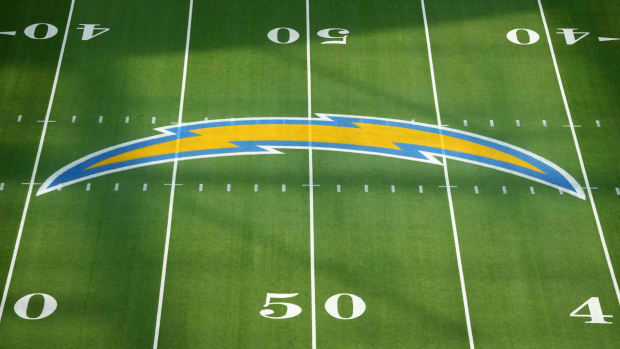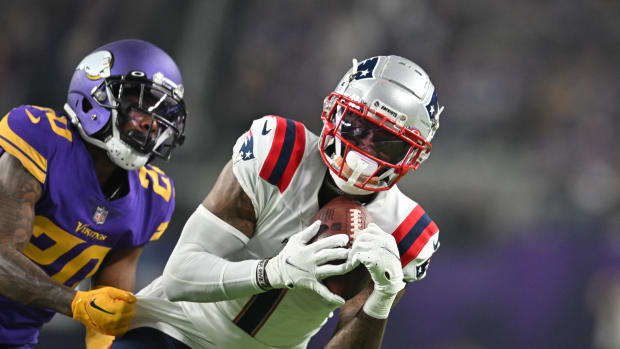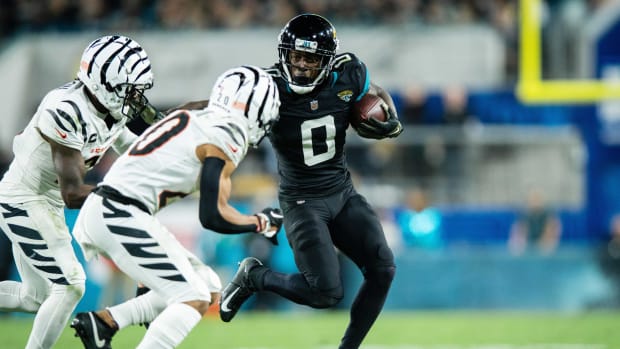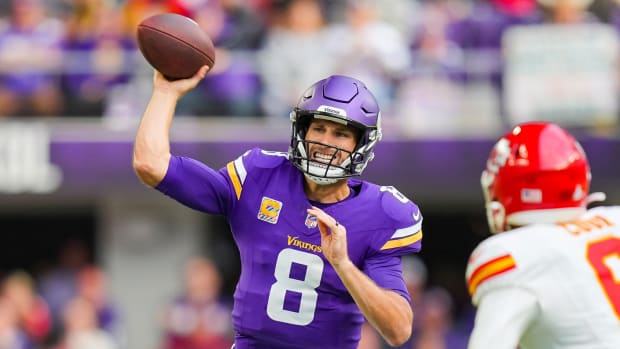How Eric Reid Can Win His Collusion Grievance Against the NFL ... and How the NFL Can Win
First it was Colin Kaepernick. Now it is Kaepernick’s former San Francisco 49ers teammate, safety Eric Reid. On Wednesday, the NFLPA confirmed a report by ESPN’s Dan Graziano that the 26-year-old Reid—who joined Kaepernick in kneeling during the National Anthem—has filed a collusion grievance against the NFL. Los Angeles attorneys Mark Geragos and Ben Meiselas, both whom represent Kaepernick, will represent Reid in the grievance.
A good player who remains unemployed
To the surprise of some NFL observers, Reid is currently a free agent and not drawing much interest from teams. He spent the last five seasons with the 49ers, who drafted the 6' 1", 213-pound safety with the No. 18 pick in the 2013 NFL draft. As a rookie, he was named first-team All-Pro, selected to the Pro Bowl and earned a spot on the Pro Football Writers Association All-Rookie team. Although Reid has not made the All-Pro or Pro-Bowl team since 2013, the former first round pick out of LSU remains a respected starting safety. He is considered versatile and hardworking. Plus, at only 26 years old, Reid should still have several productive seasons ahead of him. Off the field, Reid is regarded as a good teammate and he has not encountered any legal troubles.
The fact that Reid remains a free agent with the start of training camps less than three months away has sparked curiosity and invited speculation. To that end, while some NFL observers attempt to explain away Kaepernick’s absence from the NFL on grounds that his style of quarterback play isn’t a good fit for certain teams’ offenses and that his high profile doesn’t fit the mold of a backup quarterback, such arguments obviously don’t apply to Reid.
It appears that Reid engaging in national anthem protest has aggravated at least one owner of a team in need of a safety. Pro Football Talk’s Mike Florio recently reported that when Reid visited the Cincinnati Bengals in April, owner Mike Brown repeatedly asked Reid about his national anthem protest. Brown also reportedly told Reid, who has suggested he might not continue to protest the anthem next season, that he intends to forbid Bengals players from protesting. The Bengals did not sign Reid and published reports indicate the Bengals did not offer a contract. It does not appear that Reid has not visited any other teams this off-season.
Lamar Jackson’s Time Is Coming, Sooner Than You Think
How Reid can win a collusion claim—and how the NFL can defeat it
Reid’s grievance will track the one filed by Kaepernick last year, which means that Reid’s grievance must comport with the requirements of Article 17 of the collective bargaining agreement signed by the NFL and the NFLPA. Article 17 concerns acts of collusion that occurred within the previous 90 days. For Reid, then, the act or acts of collusion against him must have taken place sometime between the start of February and today.
Collusion is a technical term. It requires at least two NFL teams, or the NFL and at least one team, having conspired to deny a player of a collectively bargained right. As with Kaepernick, Reid’s grievance concerns his right to sign with an NFL team.
In order to prove collusion Reid must show, by a clear preponderance of evidence, that there was an agreement or formal understanding between at least two teams, or the NFL and at least one team, to not sign him. Each team deciding, on its own, to not offer Reid a contract would not constitute collusion. This would be true even if each team, on its own, decided not to offer Reid a contract solely because each team’s owner disagreed with Reid’s politics or Reid’s position on the national anthem.
In other words, while discussion of collusion in the NFL revolves around various strains of contemporary political debate, the key to proving collusion as a legal concept is not about politics. Instead, a player must establish that there was an agreement to exclude him. This necessitates proof of a “meeting of the minds.” Such a requirement is consistent with the dictionary definition of the word “collusion,” which derives from the Latin word “colludere”. When translated to English, colludere means to “have a secret agreement.” What does this mean for Reid (and Kaepernick)? It means proving that a team doesn’t want to sign a player because he won’t stand for the anthem isn’t enough. That team must have worked out some sort of arrangement with another team or the league.
Reid and his attorneys, then, need to offer evidence and/or witness testimony of an agreement. Possible evidence could include videos, recordings, text messages, emails, social media exchanges and phone call transcripts of executives from different teams interacting with one another about Reid. The more persuasive the evidence that teams’ executives decided it would be advantageous to not sign Reid, the more persuasive a collusion claim for Reid. Likewise, if Reid believes that witnesses with decision-making authority at NFL teams or the league itself would admit under oath that they discussed not signing Reid, Reid may be able to convince an arbitrator to infer that there was collusion.
A recently published New York Times transcript of an October 2017 meeting between a group of NFL owners, league officials and players—including Reid—will likely play a key role in Reid’s grievance. I analyzed the legal impact of the meeting’s transcript on Kaepernick’s collusion grievance in a The MMQB article published last Wednesday. The meeting featured several owners expressing worry that Kaepernick’s actions had angered President Donald Trump and caused the president to lash out against the league. Owners are understandably worried that Trump, who advocates for tax law changes that would financially disadvantage some owners, would pursue a policy agenda that harms the league. If owners’ concerns about Trump made them more inclined to collude against Kaepernick, then the same logic could hold true in regards to Reid.
The NFL, of course, will argue that there was no collusion and that Reid’s unemployment has nothing to do with anything illegal. As a factual matter, the league can point out that other talented safeties, including former New Orleans Saints safety and fellow 2013 NFL draft first round pick Kenny Vaccaro, are still without contracts for the ’18 season. It is also unclear as to the kind of contract Reid seeks: if he demands more money than teams are willing to pay him, then he is arguably a victim of unrealistic expectations.
Reid’s grievance will take time and won’t necessarily end if an NFL team signs him
Reid’s grievance will probably extend well into the 2018 regular season. (Keep in mind, Kaepernick’s grievance was filed last October, and six months later, it remains unresolved.) It will be up to arbitrator (and University of Pennsylvania law professor) Stephen Burbank to determine if Kaepernick has shown a clear preponderance of evidence. Reid’s grievance will follow the same track.
Like Kaepernick’s grievance, Reid’s grievance doesn’t necessarily have to end with arbitration. Should either player lose his grievance, he can file a federal lawsuit against the NFL (and any colluding teams) in a U.S. District Court. In doing so, the player would petition a federal judge to vacate the arbitration award. A federal lawsuit would face steep odds: judges are obligated under federal law to review arbitration awards with a high degree of deference. This is a dynamic that both Tom Brady and Adrian Peterson learned when they ultimately failed to convince federal courts to vacate arbitration awards.
Should an NFL team sign Reid, his collusion grievance could continue. As mentioned above, collusion doesn’t necessitate a league-wide conspiracy. It only takes two or more teams, or the league and one team, colluding. It would be plausible for two teams to conspire against Reid and then a third team signed him.
Proving collusion would potentially net Reid a sizable amount of money. Under the CBA, Reid would first be entitled to compensatory damages for the amount of money he lost due to collusion. Such damages are difficult to project in the abstract, particularly since an NFL team could still sign Reid before the start of the 2018 regular season. Should Reid be signed to a reasonable contract for 2018, his compensatory damages would likely prove modest. This is because even if victimized by collusion, Reid would receive from the NFL team that signs him an amount of money consistent with his market value. In contrast, should Reid remain unemployed well into the 2018 season, compensatory damages would weigh the contracts of safeties comparable to Reid in terms of age and talent. This could lead to a potentially large compensatory damages award.
Per the CBA, Reid would also be awarded “punitive damages”—damages designed to punish the NFL and offending teams—of twice the value of his compensatory damages. In other words, if Reid wins his collusion case, he would receive three times the compensatory damages.
Reid and the NFL could also reach a settlement in their grievance proceeding before an arbitrator’s decision.
We’ll keep you posted.
Michael McCann is SI's legal analyst. He is also the Associate Dean for Academic Affairs at the University of New Hampshire School of Law and co-author with Ed O'Bannon of the new book Court Justice: The Inside Story of My Battle Against the NCAA.





































